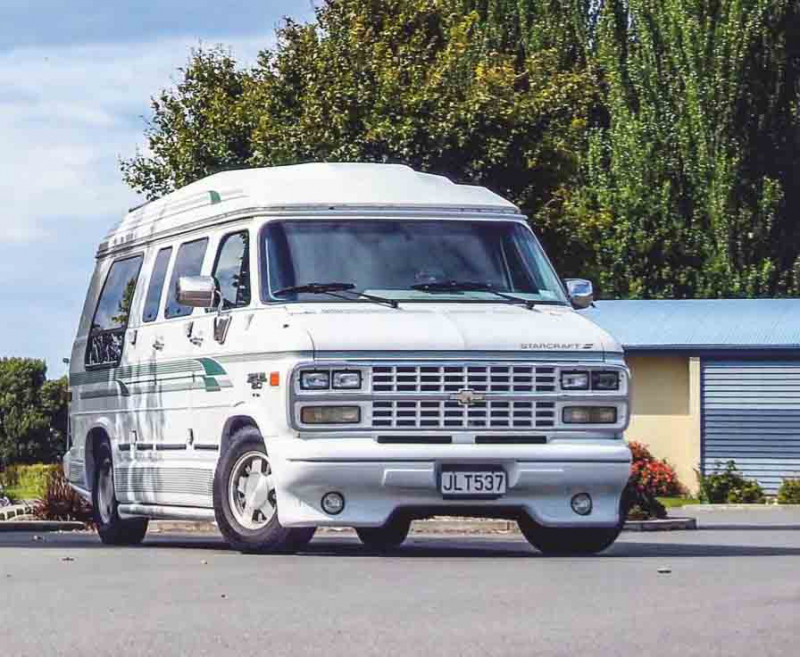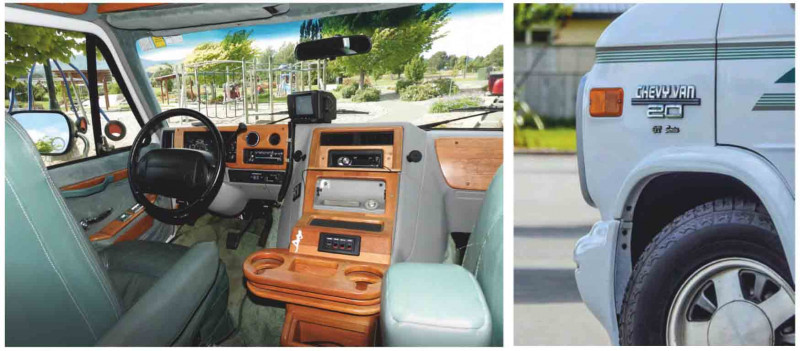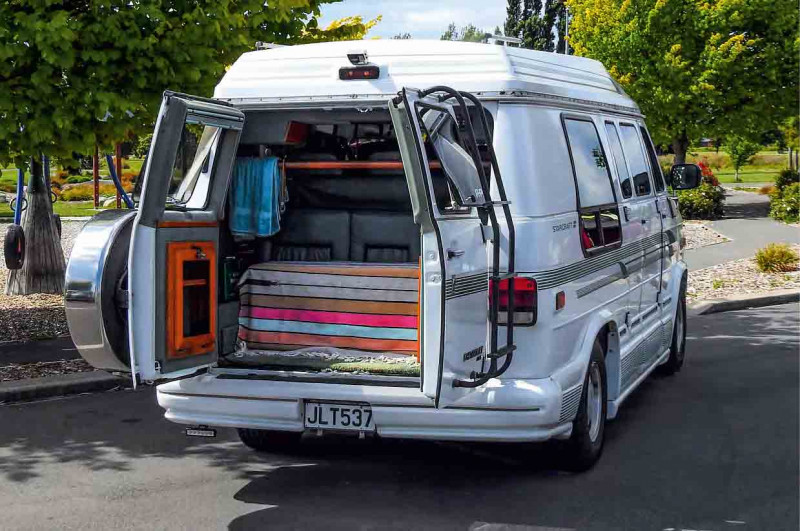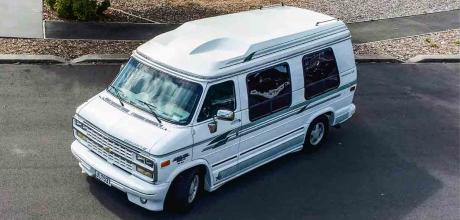1995 Chevrolet G20 Starcraft
Fads in the car world have left a legacy of weird and wonderful creations, but one of the most comfortable niche vehicles has to be the luxury panel van…
By Patrick Harlow
CHEV VAN IS A STAR
CHEV STARCRAFT VAN LUXURY ON WHEELS
Big families have always required big transport. Back in the ’60s and early ’70s, it was the Holden and Ford station wagons that filled the bill, comfortably fitting three across the front bench seat and four kids across the back. If push came to shove in a literal sense, a couple more could sit in the back storage area. With the advent of compulsory seat-belt wearing for all occupants and cars shrinking in size, families moved into commercial vans that had been repurposed with several rows of seats. The bigger the family, the bigger the van. Most of these were utilitarian but they did the job, if not with good grace, their rubber floor mats and upright seats remaining resolutely commercial in character.

This era also coincided with the panel van craze. Van customisers and enthusiasts from all walks of life would buy cheap CF Bedford or Transit vans and fit them out with exotic furnishings, giving them a nickname and a reputation that was mostly hearsay and possibly undeserved. More often than not, the so-called shaggin’ wagons were rolling pieces of art, actual vehicles of self-expression, as can be attested by the tens of thousands that visited van shows around the country. The van craze probably started with the hippie generation and the VW Kombi, but it hit its short stride in the late ’70s, peaking in the ’80s.

MANUFACTURERS MUSCLE IN
The big automotive manufacturers, always one step behind pop culture, took note of it and started to build vehicles for the new market. Starting with a commercial van, they added a few extra seats, wild graphics to the exterior and strangely shaped windows.
Under the bonnet, initially, lurked the conventional four-cylinder engines designed simply for getting goods from point A to B. Over time, these were upgraded to bigger and more powerful engines.
A classic example of this is the Holden panel van, which featured factory graphics, a five-litre V8, and bucket seats. The three-on-the-tree column change was upgraded to four-on- the-floor. Many will remember that alongside the Holden Sandman, we had the Ford Sundowner and Chrysler Drifter.

But for the best in the business, we need to look to the US, where excess comes naturally. As elsewhere, the purpose of most vans in the US was to carry cargo, which led to the classic big steel box on wheels. They were simple to design and cheap to build. Customers were more interested in cargo capacity than looks or 0–100kph acceleration times. Because functionality was more important than style, the same van could be produced in some instances for decades with very few tooling changes.
It was a very different story in the car market, which had grown accustomed to something new – either a facelift for each year or a new model replacement every three to six years. In the ’50s, it was not unusual for a completely new model of car to come out each year.
As just changing the shape of the headlight required new steel dies to be machined so that the different panels and brackets could be stamped out, the tooling and design costs for cars in this era must have been horrendous – but presumably still worth it.
CONVERSION THERAPY
As commercial customers would rather have lower purchase prices than new chrome bits, the van production cycles sometimes stretched out to decades, which surely led to substantial profit margins on these vehicles.
That conservative approach no doubt added a little spin to the growth of aftermarket customising businesses. Catering to the new lifestyle van customers, conversion companies sprang up during the early ’60s, mainly buying raw cargo vans and turning them into campers. With the arrival of the ’70s vans, also became sporty lifestyle vehicles, requiring wild graphics, funky windows, and bucket seats.

Sportiness in US terms also means a V8 engine, so orders for V8-powered vans doubled over this period. Following on the heels of the panel van, many customers started specifying luxury features such as thickly padded interiors and quality wood trim with recessed or eye-catching ‘solar system’ interior lights. The luxury van market, despite being small by US standards, was very profitable. In the US, sales in this niche market eventually peaked in the late ’80s, with an estimated 200,000 custom vans being sold in a single year.
Naturally, any peak is followed by a decline. By the ’90s, sports van sales were being cut into by a new kind of people carrier, the ‘MPV’, or ‘multipurpose vehicle’. The MPV would be king of the hill for a while when there was a need to transport seven or more people. These days, the MPV market is under threat from the ‘SUV’, or ‘sports utility vehicle’, mostly based on utes. Well, if they could add the word ‘sports’ to a van and get more sales, it is not a big leap to expect the same thing to happen by adding the word ‘sports’ to a truck, even if fancy graphics and wild wheels do not make the trucks or vans perform any better General Motors’ (GM’s) production of full-size vans decreased by 22 per cent in 1995, significantly curtailing the number of van bodies/chassis available for conversion. The following year, all three major automakers cut back their production. The days of the factory ‘custom’ conversion van were over. There is still demand for van conversions in the US, but it will never reach the heady extremes of the ’80s and ’90s.
CHANGE OF LIFESTYLE FOR GOLDEN OLDIE
The Chevrolet G20 van featured here was manufactured in 1995, when the day of the big van was just about over. This Chevrolet G20 is one of the last of the GM-designed G-Series vans. The G-Series platform was a huge success story for GM, with only minor changes made during its 25-year (1971–’96) production run, making it one of the company’s longest running vehicle platforms.
At first glance, it could be mistaken for a Vauxhall CF Bedford, also owned by GM at the time, but, while similar in style, the two shared no parts. The G-Series vans were sold by both Chevrolet as the ‘G20’ and GMC as the ‘Vandura’. The most obvious visual difference between the two was the front grille and badging.
Like the CF Bedford, the G-Series was sold in a range of formats, the most common being the cargo van, with a range of different wheelbase lengths and cargo-carrying capacities. It was also sold as a cab and chassis. Many of these were converted by aftermarket specialists into flat deck light trucks, camper vans, and even small school buses.
To keep up with the panel van craze, Chevrolet brought out a range of vans geared to this market. Customers could opt for a variety of engine choices, from the 4.1-litre inline-six to the 7.4-litre V8. For the entry-level non-commercial G20, wild graphics were added to the exterior, along with a couple of strangely shaped windows, and it was called the ‘Sportvan’. The top-of-the-range example was called the ‘Beauville’ and had a plush interior with electrically adjustable leather seats.
The most famous G-Series van of this era was one produced by GMC for the TV series The A-Team (1983–’87). The A-Team van was depicted in two-tone black and metallic grey with a red stripe. Attached to the roof was a cool-looking but surely pointless red spoiler. It was driven in almost every episode by BA Baracus, aka Mr T. An interesting nerdy fact is that a black Ford Econoline van was sometimes subbed in for some of the more explosive stunts.
Our 1995 G20 van shares its DNA and several parts with The A-Team van but is about 10 years newer.
RISING STAR
In 1977, the Starcraft Van Conversions Corporation was founded to take advantage of the new custom van market. At that time, most van conversion companies were specialising in sporty vans for the young recreational market. Starcraft decided to target an older market and offer luxury upscale vans for middle- and upper-income buyers. The demand was there, and the number of luxury van conversions continued to increase throughout the boom period of the ’80s.
Starcraft broke new ground with the introduction of the Integrated Seat Belt (IBS) in the mid ’90s, a new safety feature for its custom vans. The new seat-belt system was intended to prevent seat-back failure during rear-impact collisions. In addition to the conventional lap belt and shoulder harness, the IBS incorporated a second belt that ran through the seat back. In lab and crash tests, the system held the seat back in an upright position during impact, preventing crash-test dummies from slamming backward. IBS was named one of the 100 most technologically significant new products of 1994 by R&D magazine and was featured in 1995 on a nationally televised segment of Inside Edition. Starcraft survived by diversifying in line with public demand and offered conversions ofthe Jeep Grand Cherokee and the Plymouth Voyager.
Without a doubt, the 1995 Chevrolet G20 Starcraft was the ultimate luxury family vehicle, costing well over US$30K in its day (about NZ$116K in today’s money). As the segment’s popularity has waned somewhat, Michael Schrader bought the 1995 example shown here for a lot less than that.
TIP-TOP INTERIOR
Michael’s example started life as a long-wheelbase 5.7-litre V8 cargo van before it was shipped directly from the Chevrolet factory to Starcraft. Once in the factory, the roof was removed and a new fibreglass hi-top added. The interior then received a complete fit-out in solid walnut wood trim. Some vans received a more expensive teak interior. Slotted into the wooden trim around every window is a blind that gently concertinas down to give full privacy.
Next, emerald green leather seats were added. These are fully powered and adjustable in just about every way. Push a button, and the rear seat converts gracefully into a double bed. The middle seats, captain’s chairs, can be swivelled around to face the rear. The thick pile carpet makes the G20 a very quiet vehicle to travel in.
Michael found his van on a Japanese auction site. Being a fan of US cars and thinking it would be the ideal vehicle for him to tour around New Zealand with his family, he placed a bid.
However, he was not going to pay silly money for one. With a firm top dollar in mind, he ended up bidding on three different Starcraft vans before he managed to acquire the one you see here. It was landed and certified in New Zealand in 2015 for the bargain price of just $10.5K.
Lurking under its bonnet was that aforementioned Chev 5.7-litre V8, sending its power to the rear wheels through a Chev four-speed automatic gearbox. The same V8 can be found in the Chevrolet Corvette and the Holden Commodore SS, but due to its size and aerodynamics, the Starcraft does not have quite the same performance. Still, having around 200 horses (145kW) under the bonnet means that any hills are treated with contempt, and when we go for a drive in it, we can feel the van’s almost three tons of American iron and wood glide effortlessly over them.
Outside, the rumble of the V8 makes an impressive sound as it idles past,most of which is lost to the vehicle’s occupants, such is the quality of the sound insulation. Passengers can instead listen to one of the two radios that have been fitted: a standard radio/ CD unit in the front for the driver and a unit in the back that requires headphones to be plugged into the rear side pillars. Naturally, each set of headphones has its own volume controls on the pillars.
When Michael bought the van, it had a TV screen mounted in a wooden cabinet that could be controlled and viewed by passengers in the back. All it took was a flick of a switch to change the headphones from the radio to the TV, but, being a Japanese import it could not play New Zealand DVDs or pick up local TV frequencies, so Michael removed it. At some stage, it may be replaced by a more modern flat-screen unit, but the jury is out on that at the moment. These days, children have their own handheld devices and communal TV watching is becoming a thing of the past.
ORIGINAL CONDITION
Another luxury feature is the separate front and back air-conditioning units ensuring that everybody can travel in comfort. Should passengers ever get bored with their devices, they can lean their seats back and stare up at the array of lights that festoon the roof and side panels.
Not being a fan of the green, Michael had intended to reupholster the seats, but they were in such good condition he left them alone. In fact, the only work he had to do was to cut a small amount of rust from around the windscreen. The car landed in the condition you see here with 98,000km on the clock.
Being sold new in Japan means that all the gauges are in metric. The only changes Michael has made to the van besides a full tune-up are to the suspension. When he first drove the van, he says it wallowed around and over the road like a yacht, so he decided to stiffen up the springs. Riding in the van, we are only able to detect a little body roll, and the van proves to be very capable of absorbing the still-bumpy Christchurch earthquake–battered roads.
Michael’s first family trip was from Christchurch to Tata Beach in Golden Bay. A minor concern about how the van would fare going over the Lewis Pass and up the Tākaka Hill was quickly eased, as the V8 had power to spare and took the steep climb in its stride. Going down the other side, the disc brakes proved up to the task. Since then, the seven-seater van has travelled around the South Island with family and friends.
When not in use, the van is parked beside another US vehicle that Michael has owned for 20 years, a 1979 Pontiac Firebird. With such longevity of ownership, we are sure it is going to be decades before he loses interest in what was the US’s most luxurious form of family transport.
Michael and his family have enjoyed many fun-filled excursions in the luxury-packed van.
At the push of a button, seats fold flat to form a luxurious leather double bed.
The luxury extends to a wooden towel rail, coat hanger, or makeshift wardrobe.
Michael found his van on a Japanese auction site. Being a fan of US cars and thinking it would be the ideal vehicle for him to tour around New Zealand with his family, he placed a bid
Vertical panels beside the speaker look amazing when they light up. The panoramic view out of the window can be shut out by the curtains that gently concertina down.
A luxurious interior that can compete with an English gentlemen’s club Take an inner-city cargo van, add some bling, a V8 engine, and a bit of luxury, then, finally, add the word ‘Sport’ and the buyers will come.
With the explosion of the popularity of sports vans, the conversion van industry suddenly found itself at the entrance to what had previously been an untapped market
Following on the heels of the panel van, many customers started specifying luxury features such as thickly padded interiors and quality wood trim with recessed or eyecatching ‘solar system’ interior lights
Wood finish is not a thin piece of veneer or laminated plastic. Instead, each piece of wood has been carved out of a genuine tree. The dash-mounted TV screen is for a period-correct aftermarket backing camera
The big automotive manufacturers, always one step behind pop culture, took note of it and started to build vehicles for the new market


